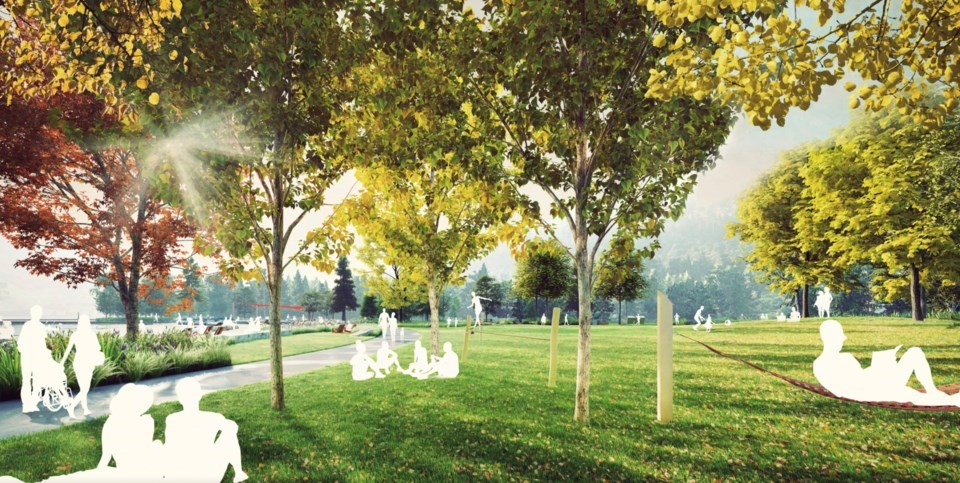The Resort Municipality of Whistler (RMOW) has offered more insight into the decision-making process around its plans to upgrade Rainbow Park, days after planners revised their designs to incorporate community feedback on two of the project’s most divisive elements.
On Feb. 22, Mayor Jack Crompton confirmed the paved Valley Trail connection originally slated to run parallel to the park’s beachfront has been removed from the draft plans, a proposal that drew significant opposition from residents who questioned the need to add more pavement to the park and worried about the potential safety risk, with additional users expected on the paved promenade.
Originally intended to improve lake accessibility for wheelchair users, instead of the promenade loop, the RMOW plans to “provide beach mats to allow wheelchair users to come onto the beach itself,” the RMOW’s communications department said in an email. “This new piece is a great suggestion received from a resident.”
The other change to the draft plans based on community feedback will see the paved food-truck pavilion trimmed to half its original proposed size, enough to accommodate a single truck at a time.
At press time, more than 3,000 people had signed a change.org petition calling for the municipality to consider alternate design plans for the park, particularly regarding the beachfront promenade.
“We are working to incorporate the feedback we’ve received since our first presentation of the designs [in January], and appreciative of the community’s input and dedication to making this the best project possible,” the RMOW said.
One major criticism that has been lobbed at municipal hall was the distinct lack of community consultation before the draft plans were unveiled. Although the RMOW based the designs on public input it received through its Outside Voice initiative, an extensive community engagement launched in 2018 to help guide the future of all of Whistler’s major parks, there was no formal opportunity for residents to consult on the plans for Rainbow Park, specifically.
“There was a pause between that [Outside Voice] engagement and this rollout, due to COVID, and in retrospect it would have been nice to present the design for one more Rainbow-specific engagement,” the RMOW said. “The dilemma facing municipal staff was that the [Resort Municipality Initiative] funding source requires a construction timeline, which sees the whole project completed by next spring, which made pressing forward the priority to meet critical summer construction timelines.”
The RMOW said it expects to award the construction contract in April. The work will necessitate a months-long closure of the park, either this summer to the fall, or this fall to spring 2024, the municipality has previously indicated.
Committee members say they raised same concerns months ago
When the proposed Rainbow Park plans were first unveiled in January, it didn’t take long for local opposition to mount. But, at least according to two community members at large on the municipal Recreation and Leisure Advisory Committee (RLAC), many, if not all, of the same concerns were raised behind closed doors months ago.
Both members Pique spoke with said the committee voiced issues with plans for the paved promenade, the food-truck pavilion, and the expanded beach area as early as last summer.
“We are to be an advisory group on behalf of the community, so when this came up and I looked at it, my jaw dropped in terms of the Valley Trail being realigned,” said RLAC member Dawn Titus, a former candidate for council who has been an outspoken—and, at times, adversarial—critic of the RMOW in the past. “I raised the concern right away … and [a RMOW planner’s] first reply to me was that I wasn’t the first one to raise that.”
A municipal communications official confirmed that RLAC members did provide feedback, particularly around the Valley Trail, following the committee’s July 14 meeting.
“Those questions, along with feedback from the community, did give our team pause,” the official said. “While we were initially leaning toward accommodating some operational requests with the first design, we made the decision to adjust and we’re working on this redesign now—as we’ve stated.”
As the RMOW gets set to undergo an extensive review of its existing committees of council, the RLAC members said they felt like their input wasn’t taken seriously by municipal staff, who repeatedly justified the proposed plans through technical “planner speak.”
Part of the reason behind the municipality’s committee review is to ensure “every time the RMOW convenes a group of residents and stakeholders for input, there is clarity around the purpose of the discussion, the participants feel valued for their contribution and are able to clearly see where their feedback has been captured and considered in the municipality’s work,” according to a municipal report last month.
The RMOW is also “making a major shift to focus on our community engagement by creating a new Community Engagement and Cultural Services Division,” the comms department explained in an email. “How we work through our projects with the community is very important to us, so we’re making it a focal point in our organization.”




